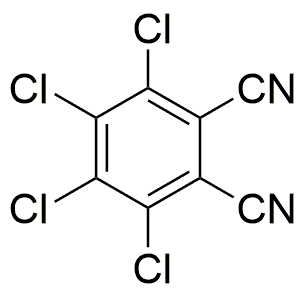Tetrachlorophthalonitrile is widely utilized in research focused on:
- Pesticide Production: This compound serves as an intermediate in the synthesis of various pesticides, providing effective solutions for agricultural pest management.
- Dye Manufacturing: It is used in the production of dyes and pigments, particularly in textiles, offering vibrant colors with excellent stability.
- Polymer Chemistry: Tetrachlorophthalonitrile is a key ingredient in creating specialty polymers, enhancing material properties such as heat resistance and durability.
- Analytical Chemistry: This chemical is employed in analytical methods for detecting and quantifying other compounds, aiding researchers in environmental monitoring and quality control.
- Research Applications: It is often used in laboratory settings for studying chemical reactions and mechanisms, providing insights that can lead to the development of new materials or processes.
General Information
Properties
Safety and Regulations
Applications
Tetrachlorophthalonitrile is widely utilized in research focused on:
- Pesticide Production: This compound serves as an intermediate in the synthesis of various pesticides, providing effective solutions for agricultural pest management.
- Dye Manufacturing: It is used in the production of dyes and pigments, particularly in textiles, offering vibrant colors with excellent stability.
- Polymer Chemistry: Tetrachlorophthalonitrile is a key ingredient in creating specialty polymers, enhancing material properties such as heat resistance and durability.
- Analytical Chemistry: This chemical is employed in analytical methods for detecting and quantifying other compounds, aiding researchers in environmental monitoring and quality control.
- Research Applications: It is often used in laboratory settings for studying chemical reactions and mechanisms, providing insights that can lead to the development of new materials or processes.
Documents
Safety Data Sheets (SDS)
The SDS provides comprehensive safety information on handling, storage, and disposal of the product.
Product Specification (PS)
The PS provides a comprehensive breakdown of the product’s properties, including chemical composition, physical state, purity, and storage requirements. It also details acceptable quality ranges and the product's intended applications.
Certificates of Analysis (COA)
Search for Certificates of Analysis (COA) by entering the products Lot Number. Lot and Batch Numbers can be found on a product’s label following the words ‘Lot’ or ‘Batch’.
*Catalog Number
*Lot Number
Certificates Of Origin (COO)
This COO confirms the country where the product was manufactured, and also details the materials and components used in it and whether it is derived from natural, synthetic, or other specific sources. This certificate may be required for customs, trade, and regulatory compliance.
*Catalog Number
*Lot Number
Safety Data Sheets (SDS)
The SDS provides comprehensive safety information on handling, storage, and disposal of the product.
DownloadProduct Specification (PS)
The PS provides a comprehensive breakdown of the product’s properties, including chemical composition, physical state, purity, and storage requirements. It also details acceptable quality ranges and the product's intended applications.
DownloadCertificates of Analysis (COA)
Search for Certificates of Analysis (COA) by entering the products Lot Number. Lot and Batch Numbers can be found on a product’s label following the words ‘Lot’ or ‘Batch’.
*Catalog Number
*Lot Number
Certificates Of Origin (COO)
This COO confirms the country where the product was manufactured, and also details the materials and components used in it and whether it is derived from natural, synthetic, or other specific sources. This certificate may be required for customs, trade, and regulatory compliance.


